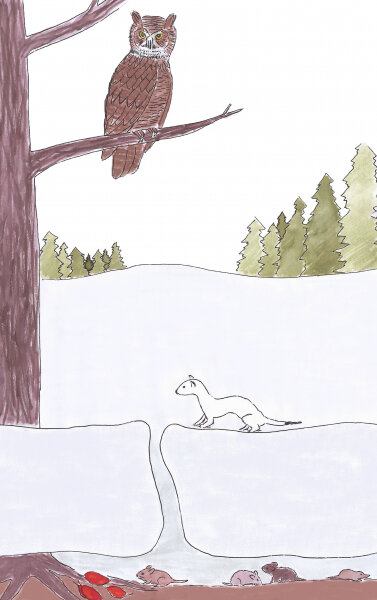Embracing the Cold: The Subnivean Ecosystem
By Jessica Nelson, Park Ranger, Mississippi National River and Recreation Area
It took awhile this year for the winter temperatures to arrive and for the snow to finally stick but when it did, humans turned up the heat and started to spend more and more of their time indoors. But what about all the wildlife outdoors? How do they feel about the arrival of snow?
Many familiar faces in the summer do not hang around for the Minnesota winters. Many birds and insects migrate south, hence we don’t see monarch butterflies or scarlet tanagers in the winter time. Many animals will go through some form of hibernation or dormancy when winter arrives; again, this is why we don’t see leopard frogs or snapping turtles wandering through snow drifts. We can see the physical adaptations that help animals deal with the cold when they remain. For example, deer and coyotes grow thicker, denser coats. Squirrels and raccoons feast in the fall and put on lots of extra pounds, and winter birds like juncos and woodpeckers can be seen puffed up as they perch on a branch.
It turns out that for many animals who do stick around, a snow layer is crucial for survival in the winter months. There is an entirely hidden world beneath the snow that we do not see so readily. We may see tiny tracks or holes on the top of the snow but other than that, life underneath can remain a mystery.
We need to dive beneath the snow down to the subnivean layer to solve this mystery. Subnivean is a latin word—niveus for snow and sub for below. So our subnivean layer literally translates to layer below the snow. This layer below the snow acts as its entirely own ecosystem! This ecosystem is critical to helping many animals in the park survive through the winter. That is because the subnivean layer is toasty warm—well, relatively toasty warm—typically around 20-30 degrees all through the winter.
This layer forms in a few ways. Some snow never hits the ground and instead piles up around or on top of rocks, roots, or thick grasses, which causes an opening between the snow and the ground. Some snow does reach the ground but through the process of sublimation in which snow goes directly from a solid state to gas state without melting. This creates a gap between the ground and the snow above. Due to heat from the ground and the insulating snow layer above, the subnivean layer maintains a stable temperature throughout the winter despite what the winds and storms may be doing above.
Why does the subnivean layer work—isn’t snow cold? Because 95% of a snowflake is air! As the snow piles up, there are a lot of air pockets that are trapped. At least 6 inches of snow are required to form a subnivean layer because the weight of the snow will begin to compress itself to keep heat from the ground trapped below, but has enough air pockets above to act as an insulating blanket.
Who is taking advantage of the subnivean layer? It turns out a huge diversity of animals rely on this for survival. Let’s start with who lives within the subnivean layer—those animals who are leaving the tiny tracks on top of the snow. The most common residents are mice, voles, shrews, and even weasels. This relatively warm ecosystem helps all of these animals conserve their energy through the winter when food supply is more limited and weather conditions are harsh. These animals then navigate through the subnivean layer through an intricate network of tunnels.
However, the subnivean layer doesn’t only benefit the animals that live within it. It also protects dormant animals like frogs. Some frogs bury themselves deep underground below the frost line or stay under the water to survive the freezing winter. But some, like the wood frog, curl up amongst a few fallen leaves. These leaves will not protect the frog from freezing temperatures. These frogs have a remarkable survival strategy—they can freeze up to 60% of the water in their body without causing damage. But if they freeze more than that, they will die. The subnivean layer acts as an insulating barrier to ensure that when these frogs get cold, they don’t get so cold that they freeze solid. Other hibernating animals like snakes and chipmunks also benefit from the insulation of the subnivean layer and keep their underground burrows from freezing. These animals burrow far enough underground to stay below the frost line. But if there is no snow layer above them, the frost line can move deeper underground, causing their burrows to freeze.
Non-hibernating animals like raccoons, rabbits, and skunks also take advantage of the subnivean layer. Although they can remain relatively active above the snow during the day, they will return to burrows dug into the snow at night to remain warmer when they sleep.
And of course, there are animals that benefit from the subnivean layer who don’t live within it or under it. Owls, coyotes and foxes will all take advantage of the buffet of prey living in the subnivean layer. With excellent hearing, owls can hear the skittering of a mouse below the snow and crash through the subnivean layer to get a meal. Coyotes and foxes will patiently wait until they hear small footsteps under the snow and then dive headfirst into the snow to retrieve a treat. Without the subnivean layer, these predators would not have such a reliable food source. And in the winter when food is scarce, this becomes a lifeline for many predators.
The next time you see a heavy snowfall in the forecast and are less than enthusiastic about the prospect of shoveling again, just remember the cozy home the snow is creating for so many creatures.





